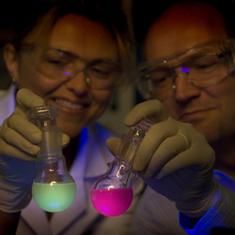Antibody-coated nanoparticles in microfluidic chip improve cancer detection 100 fold
5 February 2010
The Fraunhofer Institute for Silicate Research is developing a highly sensitive method for detecting cancer that can detect single molecules of compounds in the blood that accompany specific types of tumour.
The new diagnostic method aims to detect cancer in its initial stages so that treatment can start early and improve a patient's chance of recovery.
The technology is based on a microfluidic chip with tiny channels into which a blood sample is drawn. Specially sensitised nanoparticles in the channels capture marker proteins in the blood that are indicative of cancer.
Similar testing systems already exist but their measurements are not very precise and they can only detect molecules that are present in the blood in large quantities. What’s more, the tests have to be carried out in a laboratory, which is time-consuming and costly. The key technology is the biofunctionalized nanoparticles developed by the Institute that give the greatly increased sensitivity .
The research is being conducted by scientists at the Fraunhofer Institute for Silicate Research ISC in Würzburg and funded by the German Ministry of Education and Research.

Nanoparticles connected to antibodies are luminescent
in two spectral
ranges. This makes it possible to check
the homogeneous occupation of
the sensor electrodes.
Photo credit. Fraunhofer ISC/ Ingo
Peters
"We have improved the detection limit compared with the present state of the art by a factor of one hundred," explains Dr Jörn Probst, Head of the Business Unit Life Science at the ISC. "Whereas previously a hundred molecules were needed in a certain quantity of blood to detect tumour markers, we now need only one. This means that diseases can be diagnosed much earlier than with present methods."
"We have placed antibody-occupied nanoparticles on the sensor electrode which 'fish' out the relevant proteins. For this purpose, we repeatedly pump the blood across the electrode surface. As with a river, the flow is fastest in mid-channel and the water runs more slowly near the bank. We have therefore made a sort of fishing rod using nanoparticles which registers the antibodies in the middle of the blood flow where most proteins swim by per unit of time."
If an antibody catches the matching protein that indicates a tumour, the electrical charge distribution shifts and this is picked up by the electrode.
The researcher groups are now developing a first demonstrator combining four independent single-molecule-sensitive biosensors. The experts are also working on the simultaneous detection of several tumour markers, which will increase the clarity of tests. The system will be ready to enter the market in a few years’ time.